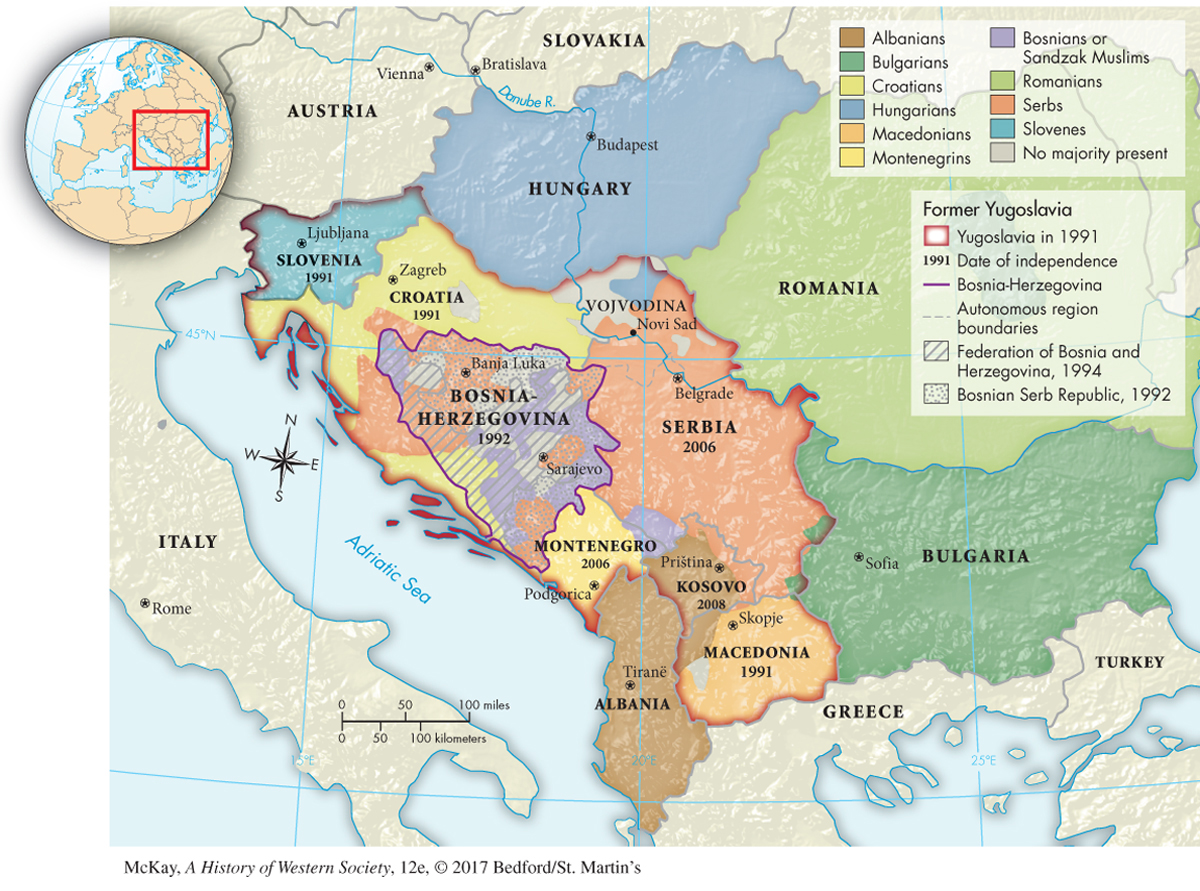A History of Western Society: Printed Page 1025
A History of Western Society, Value Edition: Printed Page 985
A History of Western Society, Concise Edition: Printed Page 1029
Chapter Chronology
Tragedy in Yugoslavia
The great postcommunist tragedy occurred in Yugoslavia, which under Josip Broz Tito had been a federation of republics under centralized Communist rule (see Chapter 28). After Tito’s death in 1980, power passed increasingly to the sister republics, which encouraged a revival of centuries-old regional and ethnic conflicts that were exacerbated by charges of ethnically inspired massacres during World War II and a dramatic economic decline in the mid-1980s.
The revolutions of 1989 accelerated the breakup of Yugoslavia. Serbian president Slobodan Milošević (1941–2006), a former Communist bureaucrat, wished to strengthen the federation’s centralized government under Serbian control. In 1989 Milošević (mee-LOH-sheh-veech) severely limited self-rule in the Serbian province of Kosovo, where ethnic Albanians constituted the overwhelming majority, but which held a medieval battleground that he claimed was sacred to Serbian identity. In 1990 Milošević supported calls to grab land from other republics and unite all Serbs, regardless of where they lived, in a “greater Serbia” (which included Kosovo). Milošević’s moves strengthened the cause of national separatism in the federation, and in June 1991 relatively wealthy Slovenia and Croatia declared their independence. Milošević ordered the Yugoslavian federal army to invade both areas to assert Serbian control. The Serbs were quickly repulsed in Slovenia, but managed to take about 30 percent of Croatia.
In 1992 the civil war spread to Bosnia-Herzegovina, which had also declared its independence. Serbs — about 30 percent of that region’s population — refused to live under the more numerous Bosnian Muslims, or Bosniaks (Map 30.2). Yugoslavia had once been a tolerant and largely successful multiethnic state with different groups living side by side and often intermarrying. The new goal of the armed factions in the Bosnian civil war was ethnic cleansing: the attempt to establish ethnically homogeneous territories by intimidation, forced deportation, and killing. The Yugoslavian army and irregular militias attempted to “cleanse” the territory of its non-Serb residents, unleashing ruthless brutality, with murder, rape, destruction, and the herding of refugees into concentration camps. Before the fighting in Bosnia ended, some three hundred thousand people were dead, and millions had been forced to flee their homes.

Figure 30.2: MAP 30.2 The Breakup of Yugoslavia, 1991–2006 Yugoslavia had the most ethnically diverse population in eastern Europe. The republic of Croatia had substantial Serbian and Muslim minorities. Bosnia-Herzegovina had large Muslim, Serbian, and Croatian populations, none of which had a majority. In June 1991 Serbia’s brutal effort to seize territory and unite all Serbs in a single state brought a tragic civil war.
Page 1026
While appalling scenes of horror not seen in Europe since the Holocaust shocked the world, the Western nations had difficulty formulating an effective, unified response. The turning point came in July 1995 when Bosnian Serbs overran Srebrenica — a Muslim city previously declared a United Nations safe area. Serb forces killed about eight thousand of the city’s Bosniak civilians, primarily men and boys. Public outrage prompted NATO to bomb Bosnian Serb military targets intensively, and the Croatian army drove all the Serbs from Croatia. In November 1995 President Bill Clinton helped the warring sides hammer out a complicated accord that gave Bosnian Serbs about 49 percent of Bosnia and gave Bosniaks and the Roman Catholic Bosnian Croats the rest. Troops from NATO countries patrolled Bosnia to keep the peace; by 2013 only one thousand remained, suggesting that the situation had significantly improved.
The Kosovo Albanians, who hoped to establish self-rule, gained nothing from the Bosnian agreement. Frustrated Kosovar militants formed the Kosovo Liberation Army (KLA) and began to fight for independence. Serbian repression of the Kosovars increased, and in 1998 Serbian forces attacked both KLA guerrillas and unarmed villagers, displacing 250,000 people.

Srebrenica Refugees More than 2,300 Bosnian Muslims packed into NATO trucks to flee the Serbian encirclement of Srebrenica in the spring of 1995. That July, the Serbian army massacred approximately 8,000 civilians in the city, and outraged public opinion in western Europe and North America finally led to decisive intervention against Serbia. In early 2016 twelve of the Serbian military leaders believed responsible were still on trial for crimes against humanity at the United Nations International Criminal Tribunal; eighty had been sentenced by the international court.
(Michel Euler/AP Photo/AP Images)
When Milošević refused to withdraw Serbian militias from Kosovo and accept self-government (but not independence) for Kosovo, NATO began bombing Serbia in March 1999. Serbian paramilitary forces responded by driving about 865,000 Albanian Kosovars into exile. NATO redoubled its destructive bombing campaign, which eventually forced Milošević to withdraw and allowed the Kosovars to regain their homeland. A United Nations and NATO peacekeeping force occupied Kosovo, ending ten years of Yugoslavian civil wars. Although U.S.-led NATO intervention finally brought an end to the conflict, the failure to take a stronger stand in the early years led to widespread and unnecessary suffering in the former Yugoslavia.
Page 1027
The war-weary and impoverished Serbs eventually voted the still-defiant Milošević out of office, and in July 2001 a new pro-Western Serbian government turned him over to a war crimes tribunal in the Netherlands to stand trial for crimes against humanity. After blustering his way through the initial stages of his trial, Milošević died in 2006 before the proceedings were complete. In 2008, after eight years of administration by the United Nations and NATO peacekeeping forces, the Republic of Kosovo declared its independence from Serbia. The United States and most states of the European Union recognized the declaration. Serbia and Russia did not, and the long-term status of this troubled emerging state remained uncertain.

